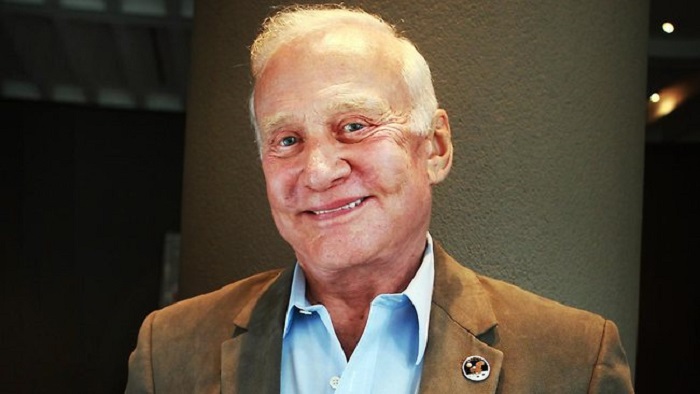.

IF NOTHING beats being an astronaut, man-on-the-moon Buzz Aldrin has got career infamy pretty much licked.
Still riveted by craters, missions, orbits, weightlessness ad living on Mars, Buzz, who followed his pal Neil Armstrong onto the moon back in 1969, now has his sight set on the next big step for man: Mars.
The astronaut, who joined the late Mr Armstrong for a globally watched and remembered leap on the moon has even gone so far as to lay out a plan to have a human colony on the Red Planet by the mid 2030s in a new book.
Mr Aldrin told news.com.au he wanted to inspire children to be intested in space.
"We need more kids to be adventurous and curious about what's out there," he said.
"We need the next generation to be our Mars generation. I'm very passionate about getting man to Mars and starting a colony there. I've outlined my plan of how to get us there in my new book, Mission to Mars coming out by National Geographic in May of this year."
Mr Aldrin is also spruiking a competition that will give Australians the chance to take a once-in-a-lifetime journey into space.
One Australian will be granted a seat aboard the Lynx spacecraft to be taken more than 100km into space, the winner going where only a select few have gone before, gaining some pretty good bragging rights in the wash-up.
With such a journey sure to excite those with a penchant to be lost in space, we caught up with Buzz who gave news.com.au the buzz on space travel.
Do you still remember every second of your monumental (1969) walk on the moon on the Apollo 11 spacecraft?
"For the most part and doing many interviews about it over the years helps to keep the memories fresh because you talk about it so often. It's a pretty memorable event though and I think most of my Apollo peers would probably remember most details of their own missions."
Was your moon walk a bond that held your friendship together with the late Neil Armstrong?
"We were certainly friends having trained together for several year and of course a bond forms from experiencing such a historical event together. We felt, and still feel that bond with our other Apollo 11 crew mate, Michael Collins. Even though he didn't get a chance to walk on the moon he was an extremely important member of our crew. He orbited the moon waiting for us to rendezvous with his spacecraft. Without him we couldn't have come home."
What can kids do to be encouraged to seek out and learn about space and aeronautics?
"Be curious, try new things, get out and be active. All of us who were privileged to be a part of the Apollo program served our country and wanted to do something helpful. We were all adventurous and so I think it takes a very adventurous spirit to go into space. We need more kids to be adventurous and curious about what's out there. We need the next generation to be our Mars generation. I'm very passionate about getting man to Mars and starting a colony there. I've outlined my plan of how to get us there in my new book, "Mission to Mars" coming out by National Geographic in May of this year."
What are the real attributes needed to become an astronaut?
You need to be brave, enthusiastic and a team player. You also need to be mentally tough. Probably most important though is having a strong stomach! These are the exact attributes we'll be judging the Lynx contestants on when they come to space camp in Florida next year.
Where can you see space travel being, in say, 50 years time?
"We're already seeing commercial space travel become a reality and I think this will continue to grow and become less expensive as technology improves. I want to eventually see commercial flights that orbit the earth."
Does a day go by you when you don't get asked or talk about space, the moon and the walk that defined a century?
"No, but I'm a space man so that comes with the territory. I care about our future in space and so it gives me an opportunity to talk about the future and what I think we should be doing to expand commercial space efforts and that more people are starting to get the chance to experience space travel for themselves."
What kind of activities will Lynx contestants be doing at space camp to try and win a seat on the space shuttle?
"Some of the activities they will have to do include the G-Centrifuge - a cockpit simulator flying in high-speed circles at the end of a mechanical arm where you experiences force up to 4.5G. The Jet Fighter Flight where you'll break the speed of sound and even get the chance to flip the plane on its head in mid-air. There is the Zero G Flight which are parabolic flights that will allow you to experience the weightlessness of space. And there is The Astronaut Assault Course, space briefings, one-to-one interviews with astronauts to help participants get ready for space travel and of course, mental aptitude tests."
Aspiring space cadets will also be judged on their bravery, enthusiasm and team work with performance counting for everything with the top Australian candidate securing a place on board the spacecraft for the mission into space.
Australians have a chance to claim one of four highly sought-after places at the Lynx Space Academy in Florida for a three-day immersion into astronaut life. Here candidates from all over the world will be tested to their limits in a series of competitive space-simulation challenges. Anyway, away you go.
Quelle: theTelegraph
